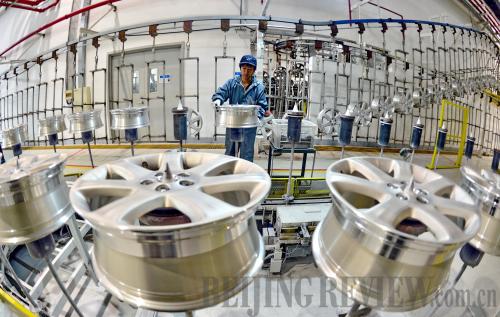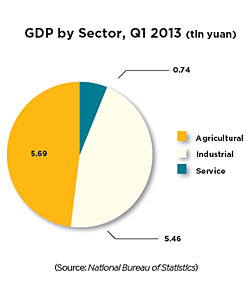|
 |
|
IN THE PLANT: Workers run a wheel production facility in Qinhuangdao-based CITIC Dicastal Co. Ltd., north China's Hebei Province, on March 5. The company has witnessed increased profits after altering its product line (YANG SHIYAO) |
The 7.7-percent GDP growth in the first quarter is a slight fall from the 7.9 percent recorded in the last quarter of 2012, leading some to claim that the Chinese economy lacks impetus. In response, Sheng said that the new government emphasizes quality economic development and is carrying out measures conducive to that end.
"The 7.7-percent GDP growth in the first quarter is within our expectations, and is not a slowdown amid a lackluster global economy. It provides a good opportunity for Chinese enterprises and local governments to transform their growth patterns and adjust their growth structure," Sheng said.
On April 15, the World Bank lowered its growth forecast for the world's second-largest economy to 8.3 percent in 2013, slightly lower than its previous prediction of 8.4 percent. The World Bank attributed the lower prediction to the Chinese Government's rebalancing efforts.
Quality growth

The NBS said that the government would continue with its fiscal and monetary policies and plans to rebalance the economy despite a complex and volatile global economic situation, saying the "economy has been kept generally stable in the first quarter" as a result of the government's ongoing efforts.
The job market is another sign of a stable economy. According to the Ministry of Human Resources and Social Security, there were over 3 million new jobs created in the first quarter in urban areas. A survey by the NBS also showed the number of rural migrant workers has increased 1.7 percent year on year during the first three months of the year.
"These two facts show that China has a sound employment condition, a sharp contrast to what's happening internationally, especially in Europe and the United States," said Sheng.
The country is facing easing inflationary pressures. The consumer price index, a main gauge of inflation, rose 2.1 percent year on year in March, and 2.4 percent in the first quarter, both lower than the same period last year.
The structure of economic growth is witnessing great change. China's growth used to be driven mainly by investment. As local governments at all levels made intensified efforts to rebalance the economy, domestic consumption is now the leading driver of growth.
Of the 7.7-percent GDP growth, 4.3 percentage points were due to consumption, roughly 55.5 percent of the total. Fixed-asset investment contributed 2.3 percentage points out of the growth, down from 3.9 percentage points of the 7.8-percent growth in 2012. Net export of goods and services contributed 1.1 percentage points, accounting for 14.2 percent of the total, said the NBS.
The service sector expanded 8.3 percent in the first quarter, 0.5 percentage point higher than growth in the industrial sector. Hi-tech industries expanded 11.9 percent in the first quarter, much higher than the growth in the last quarter of 2012 and the same period of last year.
"A conclusion can be made on the structure of the GDP growth in the first quarter: China's economic growth is now mainly driven by domestic consumption," said Sheng.
Future trend
"Judging from economic fundamentals, there are a lot of advantageous conditions for China to maintain steady growth," said Sheng.
First, China is still in the midst of industrialization and urbanization, as well as undergoing agriculture modernization and IT upgrading. The development of the Chinese market and these sectors will unleash a massive potential for consumption and investment. Second, as a vast nation, China has less-developed central and western regions, which are full of growth potential. Third, private spending is transforming from basic consumption, such as food and clothing, to higher-level consumption, such as education and travel. Finally, the Central Government has accumulated plenty of experience in macro regulation. The country's ongoing reform and opening-up efforts will yield further economic growth.
"China has much in hand to maintain long-term, continuous and healthy development. We have full confidence in that," Sheng said.
"We are optimistic," he said, about achieving an annual GDP growth target of 7.5 percent.
| 